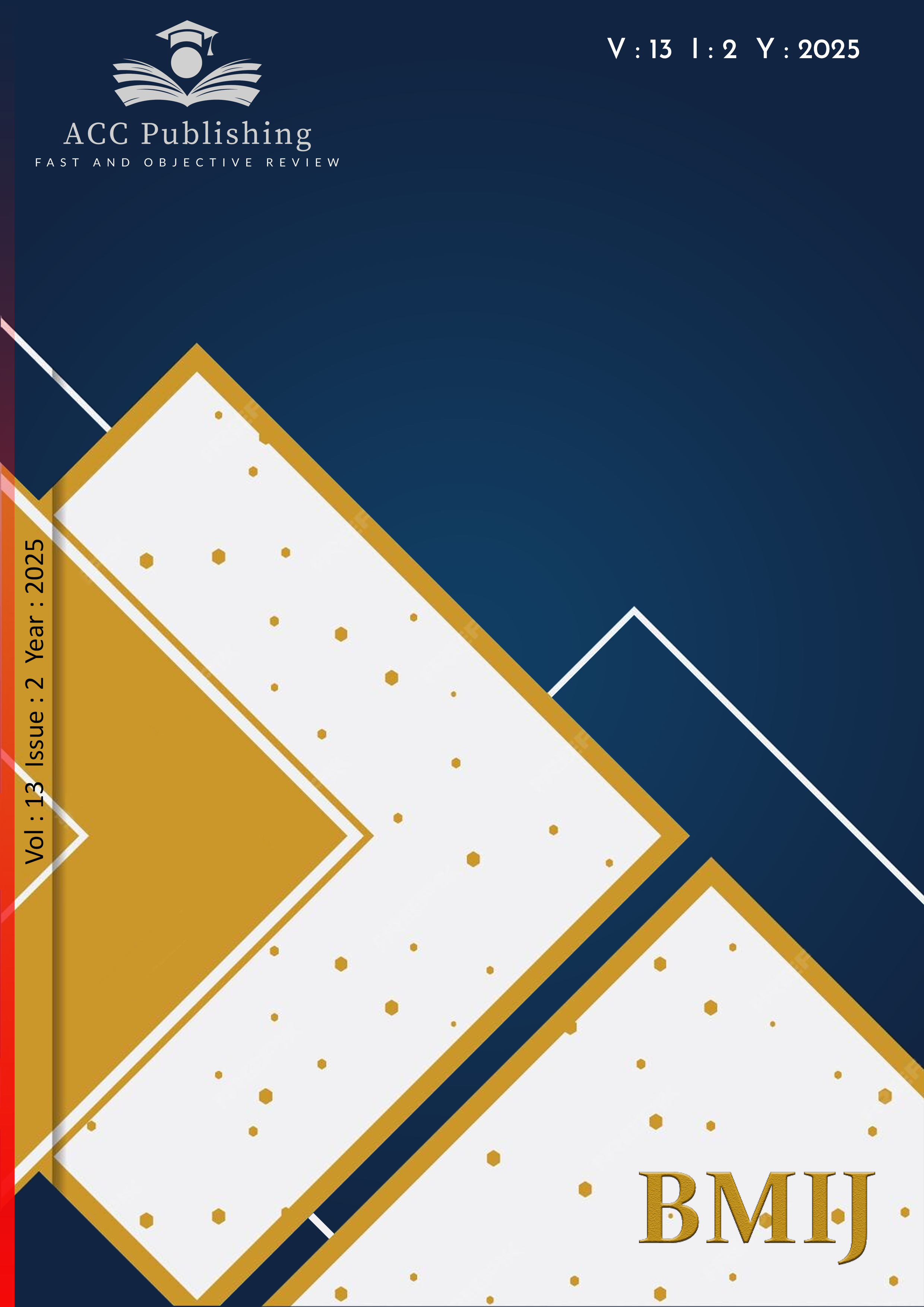The effect of lean management practices on innovative behaviour: A research for the private sector

Published 2025-06-25
Keywords
- Yalın Yönetim, Yenilikçi Davranış, Kısmi En Küçük Kareler
- Lean Management, Innovative Behaviour, Partial Least Squares
How to Cite
Copyright (c) 2025 Mustafa Altıntaş

This work is licensed under a Creative Commons Attribution-NonCommercial-NoDerivatives 4.0 International License.
How to Cite
Abstract
This study aims to determine the effect of lean management practices on innovative behaviour in private-sector enterprises. To achieve this objective, a quantitative research design was adopted, and a survey was conducted. The study population comprises organisations operating in the manufacturing and service sectors in Nevşehir. Convenience sampling was employed as the sampling method, and data were collected through an online survey, yielding responses from 415 participants. The collected data were analysed using the Smart-PLS (PLS-SEM) statistical software. The findings indicate that lean management practices adopted by businesses enhance innovative behaviour. An examination of the R2 values of the proposed model reveals that lean management practices explain 62% of the variance in innovative behaviour. These results suggest that lean management approaches play a significant role in fostering new ideas and directions within organisations.
References
- Abdallah, A. B., Dahiyat, S. E., & Matsui, Y. (2019). Lean management and innovation performance. Management Research Review, 42(2), 239–262. https://doi.org/10.1108/MRR-10-2017-0363
- Antony, J., Snee, R. D., & Hoerl, R. (2017). Lean Six Sigma: Yesterday, today and tomorrow. International Journal of Quality & Reliability Management, 34(7), 1073-1093.
- Atsan, N. (1998). Yalın yönetim yaklaşımı ve Türkiye’deki uygulamalara ilişkin bir alan araştırması (Yayımlanmamış yüksek lisans tezi). Akdeniz Üniversitesi, Sosyal Bilimler Enstitüsü, Antalya.
- Barney, J. B. (1991). Firm resources and sustained competitive advantage. Journal of Management, 17(1), 99–120. https://doi.org/10.1177/014920639101700108
- Bernardo, N. (2015). Optimising innovation with the lean and digitise innovation process. Technology Innovation Management Review, 5(3), 29–38. https://doi.org/10.22215/timreview/879
- Bonaccorsi, A., Carmignani, G., & Zammori, F. (2011). Service value stream management (SVSM): Developing lean thinking in the service industry. Journal of Service Science and Management, 4(4), 42.
- Byrne, B. M. (2016). Structural equation modeling with AMOS: Basic concepts, applications, and programming (3rd ed.). Routledge.
- Can, A. V., & Güneşlik, M. (2013). Yalın yönetim felsefesinin önemli bir boyutu olarak muhasebede yalınlaşma düşüncesi ve bir yalın muhasebe uygulaması örneği: Kendine faturalama. Muhasebe ve Finansman Dergisi, 2013(Ocak), 1-22.
- Chen, H., & Taylor, R. (2009, August 2-6). Exploring the impact of lean management on innovation capability [Paper presentation]. The Portland International Conference on Management of Engineering and Technology, Portland, USA.
- Chiarini, A., & Brunetti, F. (2019). What really matters for a successful implementation of lean production? A multiple linear regression model based on European manufacturing companies. Production Planning & Control, 30(13), 1091–1101. https://doi.org/10.1080/09537287.2019.1589010
- Cohen, J. (1998). Statistical power analysis for the behavioural sciences (2nd ed.). Lawrence Erlbaum Associates.
- Coşkun, R., Altunışık, R., & Yıldırım, E. (2019). Sosyal bilimlerde araştırma yöntemleri. Sakarya Yayıncılık.
- Çavmak, D. (2018). Sağlık hizmetlerinde yalın yönetim: Bir özel hastane koroner yoğun bakımı değerlendirmesi. Usaysad Dergisi, 4(1), 54-73.
- Çimen, İ., & Yücel, C. (2017). Yenilikçi Davranış Ölçeği (YDÖ): Türk kültürüne uyarlama çalışması. Cumhuriyet Uluslararası Eğitim Dergisi, 6(3), 365-381. https://doi.org/10.30703/cije.334136
- Derin, N. (2008). Çalışanların algılamalarına göre, yalın yönetimin iç imaja etkisi: Türkiye’deki özel hastanelerde bir araştırma (Yayımlanmamış doktora tezi). İnönü Üniversitesi, Sosyal Bilimler Enstitüsü, Malatya.
- Dombrowski, U. ve Mielke, T. (2013). Lean leadership–Fundamentals and role of leader in lean implementation. Procedia CIRP, 7, 565–570. https://doi.org/10.1016/j.procir.2013.06.034
- Edmondson, A. (1999). Psychological safety and learning behaviour in work teams. Administrative Science Quarterly, 44(2), 350–383. https://doi.org/10.2307/2666999
- Fullerton, R. R., Kennedy, F. A., & Widener, S. K. (2014). Lean manufacturing and firm performance: The incremental contribution of lean management accounting practices. Journal of Operations Management, 32(7-8), 414-428.
- Genc, T. S., & De Giovanni, P. (2020). Closed-loop supply chain games with innovation-led lean programs and sustainability. International Journal of Production Economics, 219, 440–456. https://doi.org/10.1016/j.ijpe.2018.05.026
- Gerhard, D., Engel, S., Scheiner, C., & Voigt, K.-I. (2012). The application of lean principles and its effects in technology development. International Journal of Technology Management, 57(1-3), 92–109. https://doi.org/10.1504/IJTM.2012.043953
- Godin, B. (2008). Innovation: A history of a category. INRS.
- Hair, J. F., Hult, G. T. M., Ringle, C. M., & Sarstedt, M. (2014). A primer on partial least squares structural equation modeling (1st ed.). Sage.
- Hair, J. F., Matthews, L. M., Matthews, R. L., & Sarstedt, M. (2017). PLS-SEM or CB-SEM: Updated guidelines on which method to use. International Journal of Multivariate Data Analysis, 1(2), 107–123.
- Henseler, J., Ringle, C. M., & Sarstedt, M. (2015). A new criterion for assessing discriminant validity in variance-based structural equation modeling. Journal of the Academy of Marketing Science, 43(1), 115-135.
- Hines, P., Holweg, M., & Rich, N. (2004). Learning to evolve: A review of contemporary lean thinking. International Journal of Operations & Production Management, 24(10), 994–1011.
- Janssen, O. (2000). Job demands, perceptions of effort-reward fairness and innovative work behaviour. Journal of Occupational and Organizational Psychology, 73, 287-302.
- Jin, X., Qing, C., & Jin, S. (2022). Ethical leadership and innovative behaviour: Mediating role of voice behaviour and moderated mediation role of psychological safety. Sustainability, 14(9), 5125.
- Jing, S., Li, R., Niu, Z., & Yan, J. (2020). The application of dynamic game theory to participant's interaction mechanisms in lean management. Computers & Industrial Engineering, 139, 106196.
- Kara, A. (2019). Etik iklimin işten ayrılma niyeti ile ilişkisinde algılanan örgütsel desteğin aracı rolü (Yayımlanmamış yüksek lisans tezi). Hacettepe Üniversitesi, Sosyal Bilimler Enstitüsü, Ankara
- Kumar, N., & Mathiyazhagan, K. (2020). Sustainability in lean manufacturing: A systematic literature review. International Journal of Business Excellence, 20(3), 295-321.
- Li, K., Wijaya, T. T., Chen, X., & Harahap, M. S. (2024). Exploring the factors affecting elementary mathematics teachers' innovative behaviour: An integration of social cognitive theory. Scientific Reports, 14(1), 2108.
- Messmann, G., & Mulder, R. H. (2017). Proactive employees: The relationship between work-related reflection and innovative work behaviour. In M. Goller & S. Paloniemi (Eds.), Agency at work: An agentic perspective on professional learning and development (pp. 141-160). Springer.
- Newman, A., Tse, H. H. M., Schwarz, G., & Nielsen, I. (2018). The effects of employees' creative self-efficacy on innovative behaviour: The role of entrepreneurial leadership. Journal of Business Research, 89, 1–9. https://doi.org/10.1016/j.jbusres.2018.04.001
- Nowotny, H. (2008). Insatiable curiosity: Innovation in a fragile future. MIT Press.
- Nyberg, A. J., & Ployhart, R. E. (2013). Context-emergent turnover (CET) theory: A theory of collective turnover. Academy of Management Review, 38(1), 109–131. https://doi.org/10.5465/amr.2011.0201
- OECD. (2005). Oslo manual: Guidelines for collecting and interpreting innovation data. OECD Publishing.
- Papachristopoulos, K., Gradito Dubord, M. A., Jauvin, F., Forest, J., & Coulombe, P. (2023). Positive impact, creativity, and innovative behaviour at work: The mediating role of basic needs satisfaction. Behavioural Sciences, 13(12), 984.
- Pereira, C., & Sachidananda, H. K. (2021). Impact of Industry 4.0 technologies on lean manufacturing and organisational performance in an organisation. International Journal on Interactive Design and Manufacturing (IJIDeM), 15(4), 1-12.
- Plessis, M. (2007). The role of knowledge management in innovation. Journal of Knowledge Management, 11(4), 20-29. https://doi.org/10.1108/13673270710762684
- Preacher, K. J., & Hayes, A. F. (2004). SPSS and SAS procedures for estimating indirect effects in simple mediation models. Behaviour Research Methods, Instruments, and Computers, 36, 717-731.
- Preacher, K. J., & Hayes, A. F. (2008). Asymptotic and resampling strategies for assessing and comparing indirect effects in multiple mediator models. Behaviour Research Methods, 40, 879-891.
- Rosing, K., Frese, M. ve Bausch, A. (2011). Explaining the heterogeneity of the leadership–innovation relationship: Ambidextrous leadership. The Leadership Quarterly, 22(5), 956–974. https://doi.org/10.1016/j.leaqua.2011.07.014
- Rotter, T., Plishka, C., Lawal, A., Harrison, L., Sari, N., Goodridge, D., & Kinsman, L. (2019). What is lean management in health care? Development of an operational definition for a Cochrane systematic review. Evaluation & The Health Professions, 42(3), 366-390.
- Sarstedt, M., Ringle, C. M., Henseler, J., & Hair, J. F. (2014). On the emancipation of PLS-SEM: A commentary on Rigdon (2012). Long Range Planning, 47(3), 154–160.
- Schuh, G., Lenders, M., & Hieber, S. (2011). Lean innovation–introducing value systems to product development. International Journal of Innovation and Technology Management, 8(1), 41–54. https://doi.org/10.1142/S0219877011002192
- Shah, R., & Ward, P. T. (2003). Lean manufacturing: Context, practice bundles, and performance. Journal of Operations Management, 21(2), 129-149.
- Shah, R., & Ward, P. T. (2007). Defining and developing measures of lean production. Journal of Operations Management, 25(4), 785-805.
- Shin, D., & Alam, M. S. (2022). Lean management strategy and innovation: Moderation effects of collective voluntary turnover and layoffs. Total Quality Management & Business Excellence, 33(1-2), 202-217.
- Spiegelaere, S. D., Gyes, G. V., Vandekerckhove, S., & Hootegem, G. V. (2012). Job design and innovative work behaviour: Enabling innovation through active or low-strain jobs? HIVA - K.U. Leuven, CeSO, Katholieke Universiteit Leuven.
- Tanyıldızı, İ., & Demir, Ö. (2019). Sağlık kurumlarında yalın yönetim. Fırat Üniversitesi İİBF Uluslararası İktisadi ve İdari Bilimler Dergisi, 3(1), 13-40.
- Thurlings, M., Evers, A. T., & Vermeulen, M. (2015). Toward a model of explaining teachers' innovative behaviour: A literature review. Review of Educational Research, 85(3), 430-471. https://doi.org/10.3102/00346543145579
- Tuna, A. F. (2020). Kişilik tiplerinin bireysel yenilikçiliğe etkisinde motivasyon ve personel güçlendirme faktörünün aracı rolü: Hizmet sektörü üzerine bir uygulama (Doktora tezi). İstanbul Ticaret Üniversitesi, Sosyal Bilimler Enstitüsü.
- Turan-Torun, B., Oktaysoy, O., Kobanoglu, M. S., Topcuoglu, E., Yenikaya, M. A., Topcuoglu, V., & Uygungil-Erdogan, S. (2025). Identification of heavy work investment antecedents: a research on digital leadership. Frontiers in Psychology, 16, 1588412. https://doi.org/10.3389/fpsyg.2025.1588412
- Türk Dil Kurumu. (2025). Yenilik kavramı taraması. Türk Dil Kurumu Sözlüğü. https://sozluk.gov.tr/ (Erişim tarihi: 28.03.2025)
- Türkiye İş Kurumu. (2023). İşgücü piyasası araştırması: Nevşehir ili 2022 yılı sonuç raporu. Türkiye İş Kurumu. https://media.iskur.gov.tr/66917/nevsehir.pdf (Erişim tarihi: 10.01.2023)
- Wee, H. M., & Wu, S. (2009). Lean supply chain and its effect on product cost and quality: A case study on Ford Motor Company. Supply Chain Management: An International Journal, 14(5), 335-341.
- Yıldız, E. (2021). SmartPLS ile yapısal eşitlik modellemesi: Reflektif ve formatif yapılar (2. baskı). Seçkin Yayınları.
- Zhou, J. (2003). When the presence of creative co-workers is related to creativity: Role of supervisor close monitoring, developmental feedback and creative personality. Journal of Applied Psychology, 88(3), 413-422.



